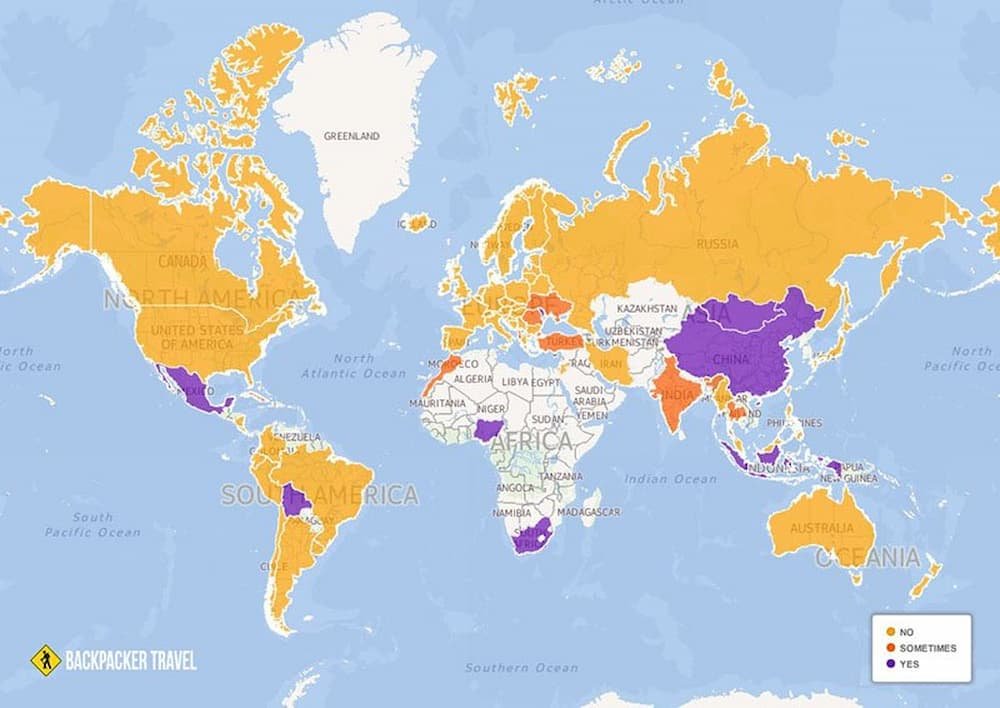"Go hitchhiking? Are you insane? A psychopath will pick me and you will find my body at the bottom of a ditch"
Unfortunately, that is what most travelers think before trying the experience. This is an understandable reaction given the media’s portrayal whenever something bad happens. Don’t get us wrong, there are most certainly risks, but, with common sense and by following some basic guidelines you will see that there are plenty of reasons to try it.
That joyous feeling you experience after you have been waiting on the side of the road for hours is something you won’t understand until you have stood there with your thumb raised.

There are plenty of good reasons why you should get out there and raise that thumb into the air. Here are some great reasons why you should give it a go:
As a budget traveler, hitchhiking is the ultimate “cheap” way to get around because, for the most part, it’s FREE. Accommodation and transport are most often the two biggest expenses in a traveler’s budget. So any opportunity you have to save some extra cash should always be welcomed as it can make a big difference in the life of a backpacker.
Be aware that there are some countries where it is commonplace to pay a fee to hitch a ride.
Wrong bus, train delay, missed connection…. sure all these conditions will test your patience at some point or another while traveling, but if you really want to become a guru in the patience department, spend a week trying to hitchhike any significant distance. Standing by the side of the road trying to flag down a ride can be tedious at best. The hours of watching cars pass by will test your patience – this is a good thing!
Technology has created a society of instant gratification. The speed and accessibility of the internet have turned us into impatient, unsocial drones. Hitchhiking forces you to live in the moment, be patient and deal with your surroundings.
Unlike a bus or train, you will have no say in the route or the schedule to get to your destination. This teaches you to be flexible and go with the flow. Say you’re in Los Angeles and you want to get to Seattle – one driver might be able to get you as far as Santa Barbara. Do you take that ride or wait for another. That flexibility is in your hands.
You never know what will happen next. The driver, the route taken, and the progress of the day. When you are hitchhiking you can never be sure where you might end up so you’re going to see places that are most certainly off the beaten track. Quite often the driver turns out to be your own tour guide, pointing out landmarks along the way. The best part, you will have the opportunity to meet lots of locals and always have a good story to tell at the end of the day.
The success of a hitchhiker is entirely based on others. Trust is the foundation of it, for both the hitchhiker and the driver. The more people you meet, the more you will hone your instincts on reading people. You will start to learn how different people react to different situations, sometimes stressful ones. This perception is a great trait to have and can translate easily into your daily life.

In some countries the fines can be costly; remember: hitchhiking is supposed to be the cheapest way to travel, not the most expensive one.
You should be able to take different roads to get to your destination.
Wear good shoes, and bring water and food. Your day on the edge of the road could be a long one so preparation is the key.
Drivers generally like to talk with their new passengers.
Bring a tent as campsites can be a good alternative if you do not.
Do NOT hitchhike during the night!
Some people swear that bright colors with high visibility get you away quicker.
A little humor will go a long way too. Something like “I do not stink” should get a smile from drivers.
As with real estate, the most important rule as a hitchhiker is choosing the best location. You need to find a place where you can be seen early.
It is important to note that hitchhiking gestures are not all the same worldwide. There are some variations but the universally accepted “thumb up” (as seen below) remains the most common sign.

Where possible it is a good idea to try to break the journey into several steps. This will give you a good excuse to get off if you feel uncomfortable with the driver or continue if they end up going further.
Finally, remember to be nice to everyone. If people notice you are friendly, you have a much higher chance of getting a ride from them!
If your journey includes crossing the border into another country, there are a few pointers you should know before trying to cross. Try to be prepared for all outcomes before even attempting to cross any border. Ask yourself these basic questions:
Do I need a visa for this country?
If so, does it cost anything?
Are there any special requirements?
Can I pay for my visa with US dollars or do I have to pay with the local currency?
Can I walk across the border?
You may have better success walking across the border and hitching from the other side. Try to arrive early in the day to allow time for processing through customs and give yourself the best chance of finding a ride on the other side.

Your safety should always come before anything else. There will be times when you have been tediously standing on the side of the road for hours waiting for a ride. This doesn’t mean you should jump in the first car that stops. By following some basic rules you will lessen the chances of something going wrong.
For women, it is recommended to dress conservatively, avoid sitting next to men, make clear that you are in a relationship, and tell the driver that somebody is waiting for you at the destination. Keep in your mind that all hitchhikers are exposed to risk. Do not hesitate to refuse a ride.

Picking up a perfect stranger, often dirty and unshaven, on the edge of the road may seem strange and even scary but the feeling you get from helping others is very fulfilling.
Remember that you are not a taxi and you have every right to refuse someone at any point. If you do decide to take a hitchhiker, first look at their luggage, is it possible to put it in your car? Next, try to make eye contact to gauge if they look friendly or not.
If you are willing to offer a ride be sure to merge off the road carefully so as not to cause an accident. Advise them in advance of your intention to stop and calculate a good distance between the other motorists, the hitchhiker, and you.
Before allowing entry to your vehicle it is wise to have a quick conversation with the hitchhiker – Where do they want to go? Where are they from? If they don’t pass your screening, simply decline politely and say that you are headed somewhere else.
At the start of the trip, there will be a mix of emotions for both yourself and the hitchhiker. A combination of excitement, relief (for the hitchhiker), and caution.
Most hitchhikers will try to chat with you as soon as you hit the road. This is your chance to find out about one another. If they are not talking it’s good to initiate the conversation as they are likely just tired from all the waiting and walking.
It is a good idea to set some basic ground rules during your initial conversation. For example, do you allow food in the car? This will also help during those quiet times when neither party feels like chatting.
To drop the hitchhiker, choose a spot at a gas station to let them go. It will be easier for them to catch another ride and you will continue your journey safely. At the end of the ride, you may have a new friend from the other side of the world.

Finally, a good question to ask yourself as a hitchhiker is:



Talk about your next destination with others at your hostel. Watch the bulletin boards. Use social networks. Ways to share the road are plentiful and keep in mind that this is an environmentally friendly way to travel.
Backpack Seat Surfing
Road Sharing
Hitchhikers Handbook
Hitchwiki
This article is for informational purposes only. Backpacker Travel does not endorse the act of hitchhiking nor take responsibility for any possible consequences arising from reading or following the information contained in this article.
